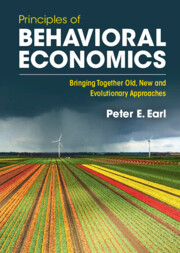Book contents
- Principles of Behavioral Economics
- Principles of Behavioral Economics
- Copyright page
- Contents
- Figures
- Tables
- Preface
- Acknowledgments
- 1 What Is Behavioral Economics?
- 2 What Motivates Us?
- 3 Why Is Life So Full of Problems for Us to Try to Solve?
- 4 How Do We Acknowledge Problems and Assess Options?
- 5 How Do We Deal with Uncertainty and Ambiguity?
- 6 How Do We Search for Solutions to Problems?
- 7 Why Do Some Things Matter More Than Others?
- 8 How Do We Choose?
- 9 How Can Firms and Governments Influence Our Choices?
- 10 What Determines the Productivity of an Organization?
- 11 How Does the Competitive Process Work?
- 12 Are There Any Behavioral Insights for Macroeconomists?
- 13 Can We Be Happy without Destroying the Environment?
- References
- Index
5 - How Do We Deal with Uncertainty and Ambiguity?
Published online by Cambridge University Press: 18 October 2022
- Principles of Behavioral Economics
- Principles of Behavioral Economics
- Copyright page
- Contents
- Figures
- Tables
- Preface
- Acknowledgments
- 1 What Is Behavioral Economics?
- 2 What Motivates Us?
- 3 Why Is Life So Full of Problems for Us to Try to Solve?
- 4 How Do We Acknowledge Problems and Assess Options?
- 5 How Do We Deal with Uncertainty and Ambiguity?
- 6 How Do We Search for Solutions to Problems?
- 7 Why Do Some Things Matter More Than Others?
- 8 How Do We Choose?
- 9 How Can Firms and Governments Influence Our Choices?
- 10 What Determines the Productivity of an Organization?
- 11 How Does the Competitive Process Work?
- 12 Are There Any Behavioral Insights for Macroeconomists?
- 13 Can We Be Happy without Destroying the Environment?
- References
- Index
Summary
This chapter explores how people characterize and cope with the cognitive challenges they face when they perceive uncertainty. Economists normally model how people think about uncertainty in terms of probability distributions assigned to rival outcomes on the dimension in question, but people commonly speak with a focus on whether outcomes are “probable” or merely “possible.” The chapter therefore explores differences between subjective probability concepts and Shackle’s possibility-based “potential surprise” view of uncertainty and his theory of focus outcomes. We also examine probability-assigning heuristics and inductive and deductive philosophies for assigning how probable or possible events might be. We then consider rule-based method by which people deal with “fundamental uncertainty,” where probabilities cannot be assigned and a leap in the dark must be made. Finally, the chapter focuses on how people deal with dread that specific problematic events may occur, including decisions to bail out of commitments due to short-run loss of nerve, leading to losses of major long-term benefits. This discussion includes analysis of how terrorism works despite low odds of being a victim.
Keywords
- Type
- Chapter
- Information
- Principles of Behavioral EconomicsBringing Together Old, New and Evolutionary Approaches, pp. 119 - 145Publisher: Cambridge University PressPrint publication year: 2022

